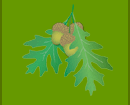 |
 |

|
|
|
 |
Paintings
Australasia

Cause for concern in Australasia
| Australasia • Tropical and Subtropical Dry Broadleaf Forests |
 |
 |
Timor and Wetar deciduous forests
Other than one remaining large block of habitat near the center of Timor, only fragments of native forest are left in this ecoregion. Deforestation is occurring rapidly, as people burn forests for hunting, shifting cultivation, and increased fodder production. Logging has gained in importance over the last decade or so as well. Native forests have been replaced by savanna areas, which are more prone to erosion. |
| Download - Full Size (PayPal) |
|
|
|
|
|
Painting 00115 |
National Geographic's Wildworld |
| Australasia • Temperate Broadleaf and Mixed Forests |
 |
 |
Chatham Island temperate forests
Much of the land has been cleared since the arrival of Polynesians and Europeans. Introduced predators have contributed greatly to the decline of bird life and invertebrates. Two of the smaller islands, Rangatira and Mangere, have been designated as nature reserves, and healthy insect and vegetation communities are thriving there. But endemic plants could be threatened with the loss of their native pollinators, the endemic birds. Fishing is a main source of income for the 750 human inhabitants, but it seems to be conducted on a sustainable basis. |
| Download - Full Size (PayPal) |
|
|
|
|
|
Painting 00116 |
National Geographic's Wildworld |
| Australasia • Temperate Broadleaf and Mixed Forests |
 |
 |
Eastern Australian temperate forests
Land clearing and drainage for industrial and urban development, landfills, invasive plants, feral animals, and human-caused fires all pose serious threats to this ecoregions vegetation. |
| Download - Full Size (PayPal) |
|
|
|
|
|
Painting 00117 |
National Geographic's Wildworld |
| Australasia • Temperate Broadleaf and Mixed Forests |
 |
 |
Fiordland temperate forests
Most of this ecoregion is protected as a national park, which has since been designated a World Heritage Area. A variety of introduced species are found in Fiordland, including the stoat and brush-tailed possum, which prey on native wildlife and harm vegetation. Lobsters are currently harvested but the once-common whaling and hunting of fur seals have been halted. |
| Download - Full Size (PayPal) |
|
|
|
|
|
Painting 00118 |
National Geographic's Wildworld |
| Australasia • Temperate Broadleaf and Mixed Forests |
 |
 |
Nelson Coast temperate forests
Logging and mining are threats in this ecoregion. Introduced mammalian predators threaten native animals, while introduced herbivores damage natural vegetation. . The remote highlands offer some protection for native animals, such as birds, that are decreasing due to habitat loss and predation. Fur seals were once hunted extensively for their pelts, but since this harmful practice was banned they have been returning to the Nelson Coast. |
| Download - Full Size (PayPal) |
|
|
|
|
|
Painting 00119 |
National Geographic's Wildworld |
| Australasia • Temperate Broadleaf and Mixed Forests |
 |
 |
Northland temperate forests
Logging, non-native animals, grazing, and human settlement and development are the main threats to habitat and to native birds. |
| Download - Full Size (PayPal) |
|
|
|
|
|
Painting 0120 |
National Geographic's Wildworld |
| Australasia • Temperate Broadleaf and Mixed Forests |
 |
 |
Northland temperate kauri forests
When Polynesians first arrived 800 years ago, they brought the first mammalian predator, the Polynesian rat, with them. Later, Europeans introduced more mammalian predators such as ferrets and stoats. New Zealands native species evolved for 80 million years in the absence of mammalian predators after splitting off from the supercontinent Gondwana. As a result, many endemic birds are flightless and completely defenseless against humans and the predatory animals that came with them. Today, introduced predators are a serious threat to bird species, while other introduced species (such as possums) devour the native vegetation. Logging, grazing, and development also pose problems. |
| Download - Full Size (PayPal) |
|
|
|
|
|
Painting 0121 |
National Geographic's Wildworld |
| Australasia • Temperate Broadleaf and Mixed Forests |
 |
 |
Rakiura Island temperate forests
The biggest threat to wildlife here is the introduction of non-native species. Some mammalian predators, such as cats and rats, have already been introduced on Rakiura Island with disastrous consequences. Native birds would be enormously depleted if other carnivores were ever introduced. In the past, whaling, seal harvesting, timber milling, tin mining, and fishing were all major industries in this ecoregion. Today, Rakiuras 500 inhabitants are involved in tourism and sustainable fishing. |
| Download - Full Size (PayPal) |
|
|
|
|
|
Painting 0122 |
National Geographic's Wildworld |
| Australasia • Temperate Broadleaf and Mixed Forests |
 |
 |
Richmond temperate forests
Raising sheep for wool is the biggest land use in this area, and much of the land has been converted to pasture. Overgrazing, logging, and feral and introduced animals are all threats as well. |
| Download - Full Size (PayPal) |
|
|
|
|
|
Painting 0123 |
National Geographic's Wildworld |
| Australasia • Temperate Broadleaf and Mixed Forests |
 |
 |
Southeast Australia temperate forests
Fire, clearcutting, selective logging, exotic pine plantations, and sheep- and cattle-grazing are all persistent threats to this ecoregion. |
| Download - Full Size (PayPal) |
|
|
|
|
|
Painting 0124 |
National Geographic's Wildworld |
All paintings © Copyright EqualEarth.com on behalf of Van Xilef.
Australasia
|
 |
 |
|
 |
|

